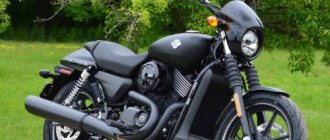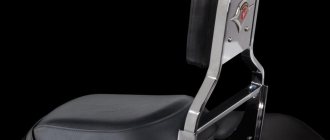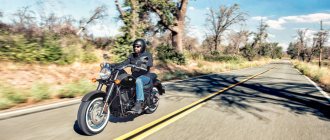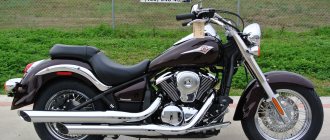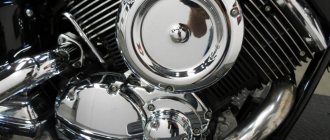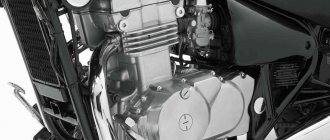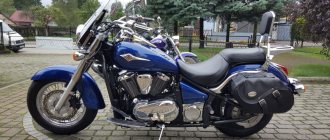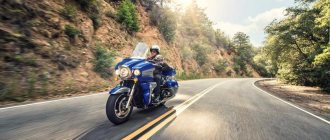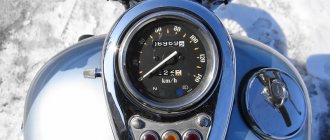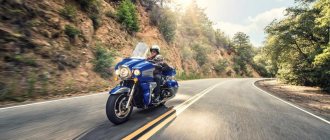2014 onwards, 903 cm3, 48 l. pp., 282 kg, 170 km/h, 460,400 rub. (price in 2021 - from 647,000 rubles)
text: Anton Vlasov photo: Nikita Kolobanov
In the photo: Anton Vlasov
»The Vulcan series cruisers are one of the oldest families of Kawasaki road motorcycles: this year the VN line turns... 30 years old! All this time, the Japanese manufacturer worked on mistakes and improved the Vulcans, which, having survived to this day, have become modern and high-tech motorcycles that have not lost the charm and allure of classic cruisers. The medium-sized model Kawasaki VN900 is the “junior” device of the legendary series, available on the Russian market.
The history of the Kawasaki Vulcan family began with the VN750 model, which debuted in the mid-80s of the 20th century. It was one of the first cruisers of the Japanese concern, equipped with a V-shaped 2-cylinder engine, and it was the “entrance ticket” to the capacious North American market. The device turned out to be so successful that it existed without major changes until 2006!
For a long time, in parallel with the VN750, the VN800 was produced, which, despite the close relationship and a slight difference in engine displacement, was a fundamentally different motorcycle, a modern cruiser, with a different engine and a pendulum rear suspension with an “invisible” Softail-style monoshock absorber.
Like the VN750, the 800 cc version was produced until 2006, when, by a strong-willed decision of the management of the Kawasaki concern, the two models were replaced by one - the VN900. As before, the motorcycle is produced in several versions: Classic, Classic Special Edition, Classic LT and Custom.
Technically, stylistically and conceptually, the basic VN900 Vulcan Classic, to which this material is dedicated, is a typical and, dare I say it, classic cruiser, the likes of which are in the model lines of all four Japanese motorcycle concerns. Steel frame, V-shaped 2-cylinder engine, large streamlined gas tank with a dashboard in the center, wide steering wheel, “thick” spoked wheels, deep fenders, round headlight and other standard features.
Although in the world of uncompromising lovers of chromed iron, the engine cylinder displacement of 903 cm3 is a rather modest value, with which, in fact, “adult” motorcycles just begin, the VN900 Classic has the most universal ergonomics: both fat and thin people can comfortably sit behind the wide handlebar of a cruiser , and tall, and “short”, and, in general, perhaps, any riders.
The only criticism I have about the Vulcan is that, in my opinion, the steering wheel is not the most comfortable, or rather the throttle handle. Due to the smooth curve of the “crossbar”, like the line of a sika deer’s antlers, and the thick accelerator handle, which form a specific grip, in my case, by the end of the day, my right hand began to ache. However, individuals with larger limbs most likely will not have problems.
The test bike was equipped with numerous branded accessories from the official Kawasaki catalogue. I don’t know whether it was intentional or not, but the set of parts was selected in such a way that the VN900 Classic “grew up” and even “outgrew” the Classic LT modification, which differs from the basic version in a high windshield, side leather trunks, a backrest for the passenger and additional headlights.
In addition to this, the test vehicle was “screwed on” with other steering wheel grips, a leather gas tank cover with a small pocket, roll bars, a large Vulcan emblem on the windshield, a luggage area and a headlight visor. I can't say that I'm a big fan of this style, but fans of such cars should appreciate it.
Real competitors
At the time of its appearance, only the American Harley-Davidson could compete with the model, but three years later Yamaxa presents its answer - the V-Star 950 version.
Harley-Davidson Street 750.
Yamaxa V-Star 950.
Cruisers of a similar class were also produced by other Japanese, but “the middle weight category is just beginning with the 900cc model. If you’re going to do it, it’s just liters,” so Kawasaki had no real competitors in this class .
The model is still in production, like previous versions, it has several modifications, excellent driving performance, traditional Japanese reliability and design in the style of a classic American cruiser.
Eyjafjallajökull
Some volcanoes are eternally sleeping mountains, more like ordinary hills, others, on the contrary, are frightening giants, in the event of a real eruption, threatening entire cities and even regions with terrible disasters... Kawasaki VN900 Classic is a volcano of a different kind, a kind of, pardon the expression, Eyjafjallajökull, which nothing special - but only until it is activated.
This motorcycle hardly stands out from the crowd of similar machines, but once you get to know it better, you won’t want to part with the VN900. The device impresses with its simplicity and predictability: despite its impressive weight and not the most modest dimensions, the Kawasaki cruiser is comfortable and completely under control even at low speeds.
Yes, the VN900 doesn’t have even a tenth of the status of American devices... which, in my opinion, makes choosing the Vulcan an even more reasonable purchase, since for significantly less money the Kawasaki motorcycle offers a high level of comfort, decent ride quality, classic design and traditional Japanese reliability with the eternal and unchanging values of equipment of this class. /
Tags
Kawasaki Cruiser Tests and Reviews Chopper
Specifications
Engine – left view.
Engine – right side view.
As a rule, a cruiser offers a sedate ride, no matter in the city or on the highway, so the engine of the new Vulcan did not receive any special technological solutions. However, the injector, as well as KDTV , a patented power management system were carried over from Kawasaki sports models.
Taking this and some other developments into account, the result is a rather interesting hybrid.
Options:
- working volume - 903 cm3;
- number of cylinders - 2;
- number of cycles - 4;
- number of valves - 8, 4 per cylinder;
- power - 50 (48) hp;
- torque - 82 (78) Nm;
- cooling - liquid;
- fuel supply - injector;
- ignition - transistor (TDI);
- start - electric starter;
- tank volume - 20 l.
In 2013, new environmental standards were adopted. In order not to close production, the engine was reconfigured. New indicators are in parentheses.
KDTV
The motorcycle is equipped with the revolutionary Suzuki Dual Throttle Valve fuel injection system.
Kawasaki Dual Throttle Valves system largely replicates similar systems from other Japanese manufacturers. For example, SDTV from Suzuki. A pair of throttle valves in the intake valves.
One is connected to the gas handle via a regular cable, the second is controlled by a servo drive. The only difference between this system and its analogues is the different diameters of the channels. Under the servo drive - less.
Transmission and clutch
A distinctive feature of the 900 Vulcan is its belt drive, which is lighter than a drive shaft and requires less maintenance than a classic chain.
Like any other cruiser, the Vulcan has a 5-speed gearbox . It works excellently , shifts clearly, and the pedal travel is also within acceptable limits. To find the neutral, engineers used an unusual solution. The neutral itself is in the standard place, between the first and second, to activate it you just need to “throw” the paw up. Special protection will block the move higher, after which neutral will be activated and the corresponding indicator on the tank will turn on.
- The standard clutch is multi-disc, oil bath . Power transmission is a cable .
- But the main drive is made in the style of American cruisers - with a belt drive .
Brakes
There is nothing special about the braking system either. Conventional discs with 2-piston hydraulic support.
Front brakes.
Rear brakes.
Front:
- number of disks - 1;
- diameter - 300 mm;
- support - 2-piston.
Rear:
- number of disks - 1;
- diameter - 270 mm;
- support - 2-piston.
No options are offered.
Design
Along with the classic style, the Vulcan motorcycle series also has a classic layout. All units are attached to the frame.
The frame design is duplex, made of high-strength steel. At the front, the suspension is presented in the form of a telescopic fork.
At the rear, a pendulum suspension with two shock absorbers is used. This suspension is adjustable.
The first motorcycles used a drum brake system on the rear wheel, while a disc brake system was used on the front wheel. Later, the rear drum brakes were replaced with disc ones.
Driving performance,
Nobody expects racing characteristics from a cruiser, so the manufacturers did not particularly boost the engine. The maximum speed of the bike is 169 km/h .
The situation is the same with acceleration - in 6.92 seconds from 0 to 100 km/h.
Fuel consumption
The developers are especially proud of fuel consumption.
The stated figure is 4.8 liters per 100 km for the combined cycle. The final result depends on the riding style, modification of the motorcycle and the capabilities of the pilot. However, by definition, it is impossible to “fry for all the money” on a cruiser.
Introduction
After reading reviews and reviews of “mid-sized” cruisers these days, I found out that for complete happiness I may well need a Kawasaki, namely the VN900 model. Having read about more or less obvious shortcomings and considering them not convincing enough to even refuse to try, I began to look for where I could touch this miracle of metric motor construction.
On the Kawasaki Nederland website, when you search for a test drive, you simply get a list of dealers. Upon closer inspection, the dealer produces a list of demo motorcycles, but not a single VN900 was on the list. There you go. I just had to google it, and as a result I found a dealer not far from Utrecht, offering to ride almost everything :). Two days after the email, the answer came - there is a rental VN900 available in the Light Cruiser configuration (as I wanted!) - available at any time. And even on the day when I was just going to be in that area. Well, don't miss this opportunity!
This was the first time I drove a car for a test. But bringing your family to the airport would be difficult any other way :). Having found a free place, I parked, changed clothes and went to seek my fortune with whomever I had agreed with. I was “assigned” to a consultant boy, who harassed me a little with filling out the necessary papers, and, finally, I was given a Vulcan. Or rather, first I had to look in the parking lot among a bunch of other motorcycles and, as usual, he was standing at the very end: in full gear, with a screen and bags. They brought him out and brought him in (without any special movements), and wished me good luck for the next hour. So, I'm alone with Vulcan.
Dimensions and weight
Typically, the user imagines a cruiser as something large, massive, and heavy. Kawasaki VN900 Vulcan decided not to break traditions.
Externally, the motorcycle is perceived as a large touring bike, while its engine capacity is less than a liter.
Curb weight, depending on modification, is from 275 to 300 kg .
It is also similar in size to a cruiser, with the exception of the Custom model, which can be called a stripped-down version:
- length - 2,465 (2,405) mm;
- width - 1,005 (894) mm;
- height - 1,054 (1,120) mm;
Seat height - 680 (685) mm .
Wheelbase - 1,646 mm .
Custom dimensions in brackets. The difference in height is explained by the fact that the wheels on the Custom are 5 inches larger ...
For whom is it intended?
A variety of modifications allows drivers of any height to choose the most suitable option.
- In the case of a road bike, a low saddle suggests comfort only for short bikers.
- In the case of a cruiser, comfort is provided to bikers of short and medium height.
In the case of the Vulcan, convenience is offered to all. 4 modifications will allow you to choose a bike that is convenient for a specific owner.
Photo gallery
Kawasaki Vulcan sounds proud and worthy! It's certainly a bike that's hard to ignore, with its spoked wheels on some models, low-slung seats and aggressively angled chrome mufflers. We present to your attention a small photo selection.
Modifications and competitors
In 2006, in parallel with the Vulcan Ckassic, the Classic LT (Light Tourer) . A year later, production of the Vulcan Custom begins. Another fourth modification, the Vulcan Classic Special Edition (SE), was produced on individual orders. Basically this was the basic version, but with a different color and slightly modified performance characteristics.
Kawasaki VN900 Vulcan Classic.
Kawasaki VN900 Vulcan Classic Special Edition.
Kawasaki VN900 Vulcan Custom.
Kawasaki VN900 Vulcan Light Tourer.
Stock modifications included:
- Kawasaki VN900 Vulcan Classic - spoked wheels, large footrests. Engine cover and exhaust pipes in chrome. Wide, comfortable seat for two passengers.
- Kawasaki VN900 Vulcan Light Tourer . The Ckassic body kit added a high windshield, side saddlebags (leather!), and a backrest for the second number. Due to the LT glass, the maximum height is 1480 mm .
- The Kawasaki VN900 Vulcan Custom features regular footpegs, minimal chrome, and a single-person saddle. Cast wheels of increased diameter.
- Kawasaki VN900 Vulcan Classic Special Edition (SE) - special order with a choice of colors. The basic version is black and white.
As already mentioned, the bike had no real competitors.
Yamaha V-Star 950
The model was intended primarily for the American market, which is why the emphasis was placed on an air vent motor.
The Yamaha V-Star 950 had the following differences:
- 942 cm3;
- air cooling;
- digital ignition;
- 1 piston on the rear disc.
Externally, the model was also offered in 2 versions, equivalent to Vulcan Ckassic and Vulcan Classic LT..
Among the Americans, several competitors could be named. The most striking was the Harley-Davidson Softail Deluxe/Fat Boy . The release continues .
Video
Not only technical specifications, various descriptions and photos can help a beginner in choosing a motorcycle. A high-quality video can also be a good help. How else can you evaluate the exhaust from standard mufflers and see the equipment in action? We present to you a test drive of one of the heroes of our article - Kawasaki Vulcan 900.
Did you like the article? Tell your friends!
Comments (1)
- Victor:
06/17/2016 at 13:03Any information on tire sizes for the front and rear and possible replacement options?
Answer
Peculiarities
Users identified only a few details as features:
- the main drive is a belt drive in the American style;
- non-standard, as for a cruiser, angle of inclination of the front fork.
Simple telescopic fork with 135 mm travel.
Flaws
Users find few disadvantages:
- 5-speed gearbox - while driving you want to engage sixth, but the transmission doesn’t have it!
- brakes - for a tank weighing 300 kg, emergency braking by the standard system only with wheel locking and skidding...
In the first years of production, the model was withdrawn from sale several times, returning to the factory for revision. The reasons were in the fuel system and generator . Owners of motorcycles from recent years of production do not voice such problems.
Advantages
Sitting on the bike is very comfortable – the transition from the driver’s “seat” to the passenger “stool” creates comfortable support for the lower back.
But the strongman clearly has more advantages.
- Large set of parts for tuning . Despite the 3 modifications in the Vulcan model range, there are windows of different heights, roll bars, various additional lights, handbags and much more.
- Well-thought-out ergonomics make the bike almost universal - for bikers of any height and build.
- Low fuel consumption . For extra-urban use no more than 4 liters .
- Controllability.
- Maneuverability.
- Fuel gauge on the instrument panel.
The instrument panel is located on the tank, as is customary for motorcycles of this class.
A low center of gravity is a plus for some, a minus for others.
Power plants by year of motorcycle production
But the range of power plants installed on this motorcycle is quite extensive.
The first Kawasaki Vulcan, as already mentioned, was equipped with a 699 cc engine. see and power indicator at 41 hp. This model was produced from 1984 to 2006.
The next unit that came with the motorcycle was a 400 cc engine. see (33. hp). A motorcycle with this engine was produced from 1986 to 2004.
Then a version with a larger engine . Its volume was 1500 cubic meters. cm and a power of 64 hp. It was produced from 1987 to 2008.
Next was a version with a 500 cc engine. cm and a power of 46 hp. Years of production: 1990-2009.
Then there were the Kawasaki Vulcan 800 (800 cc and 55 hp), Kawasaki Vulcan 1600 (1600 cc and 74 hp) and the largest Kawasaki Vulcan 2000 (2000 cc and 103 liters) .With.).
These motorcycles were produced between 1995 and 2010.
Honda CTX 700 N (2013 – present 280,000–550,000 RUR)
The CTX700N is another reincarnation of the components and assemblies of the Honda NC 700 family of motorcycles. Based on its standard size, this motorcycle can conditionally be classified as a cruiser.
Engine
The in-line two-cylinder fuel-injected power unit was originally created for the Honda Jazz. But, having parted with two pots, it also came in handy in the body of a motorcycle. Its main feature is to surprise not with performance characteristics numbers, but with perseverance. The 670 cc twin really doesn't shine with its characteristics. It is also quite noisy. However, the strength of this power unit is enviable. With proper maintenance, the owner is almost guaranteed not to encounter problems with the crank, CPG and gas distribution mechanism. And it certainly won’t add oil during the service interval. Even with long runs. It is important to be very meticulous in the valve adjustment procedure. The engine produces very little in the second half of the tachometer. Why is it often twisted? Failure to adjust the valves promptly can cause serious problems.
Transmission
In addition to the standard Honda almost perfectly working six-speed manual transmission, versions of the CTX700N are available with a DCT robotic automatic transmission (with the letter D in the name). Both options can be considered problem-free. Is that the clutch on the “mechanics” is a bit tight.
Frame and body kit
The CTX700N frame is not a masterpiece in terms of rigidity and technology. At the same time, the design of round pipes does not show any difficulty in operation. Destructive consequences occur only in very serious accidents. The body kit, even in the “stripped” N version, is replete with large plastic parts. The sides of the tail, the mask around the headlight and the exhaust system are often affected.
Brakes
The brake system, complete with a fairly large front brake disc on the scale of the genre, has been completely migrated to the CTX from motorcycles of the NC 700 family. There are models with ABS and a combined brake system C - ABS. The performance should be considered sufficient for fast piloting.
Pendants
The chassis is a little more than completely devoid of frills. One of the few blessings of civilization in the company of a boring telescopic fork and an equally boring shock absorber with adjustable spring preload is the Pro-Link linkage system around the progressive shock absorber. For relaxed cruising without any frills, this is a decent choice. The weak points of the chassis definitely include excessively flimsy rims.
Comfort
There is absolutely no desire to drive the CTX700N. And that is its main value. The motorcycle is comfortable, flexible and not ambitious. Beginners are guaranteed to love it. The low-positioned seat is ideal for small drivers.
Modifications
Production and sales of the Honda CTX700N started in July 2014. By August, the model line was replenished with a touring version of the CTX700 with increased wind protection. For 2021, only the touring version is available. As of 2021, models with manual transmission are no longer produced.
Box
The box was a very pleasant surprise. The gears are engaged softly and accurately, with the same “oil-lubricated clatter” and the same feeling. No jerking when shifting up or down. I was even surprised. It's just a real pleasure to switch. Compared to the “unbroken” custom Yamaha (apparently, the issue is rather a matter of cubic capacity) it’s simply silky.
In general, the box is configured in such a way that you need to switch (close enough to each other). On a Yamaha you could ride in second or third, but here you can use all gears. At 80 km/h you can safely drive in 4th gear. You can switch with both your toe and heel. In principle, not a problem, but in order to switch with the heel I had to move my foot “backwards”; nevertheless, switching with the toe in this regard is much more convenient (without unnecessary body movements). As a result, for the most part, I switched with my toe out of habit, but I can imagine that sometimes it’s convenient with my heel if I’m not in a hurry :).
General overview
The beauty of the custom matches the pleasure of driving
The new Vulcan 900 Custom is custom that stands out from the crowd of its classmates. It embodies Kawasaki constant search for the essence of a true custom. The appearance of the motorcycle is determined by the contrast between the massive rear wheel with a solid disc and its antipode in the form of a light, elegant front part. This bifurcation gives dynamism to the slender silhouette, the enchanting lines of which no machine alone, without a person, could create.
To achieve ease of visual perception of the front of the motorcycle, thin wheels with a diameter of 21" were chosen. However, for a true custom , a wheel with regular wire spokes is simply unacceptable. As a replacement, a cast wheel was developed, the stylized spokes of which were made by hand at the first stage of design, which made it possible to obtain an elegant three-dimensional design of two halves. This unique 21-inch alloy wheel will turn heads even when mounted on a “typical” custom. The clean and simple look of the front end is complemented by a minimalist headlight design and straight handlebar (which are chromed, naturally).
The fuel tank, equally meticulously crafted, is a key element in the design concept of the Vulcan 900 Custom. Its carefully outlined contours create an intricate play of light and shadow. Like a beautiful woman, they not only attract the eye, but also create a desire to touch. By running your hand along the gracefully curved surface of the tank, you can fully appreciate its exquisite shape, specially created to bring pleasure to everyone who sees or touches it.
Kawasaki motorcycle enthusiasts have come to expect after the mid-volume Vulcan 900 Classic and Classic Tourer LT cruisers were given the look and character of truly big bikes. Now all three models in the Vulcan 900 series feature beautifully chromed V-twin engines, sophisticated styling, reliable belt drives and massive rear tires. Their engines, specially designed for satisfying acceleration, generously provide powerful torque, characteristic only of large two-cylinder engines of this design. Add to this the easy handling of a sportbike, and you get motorcycles that are a real pleasure to ride. The Vulcan 900 Series models have raised the standards of performance, quality and craftsmanship in their class. The Vulcan 900 Custom has raised that bar again.
Devices
Vulcan turned out to be quite modest in terms of instruments. The navigator has nothing to do here :). There is the required minimum, but no more. A speedometer, a couple of lights and, oddly enough (and nicely), a fuel gauge. In general, a minimal gentleman's set for every day. Everything is quite readable, but the bottom three lights should only be viewed with your head down.
In addition to the windshield and bags, the package of the “light cruiser” also includes an additional set of lamps (popularly called a “chandelier”). In fact, the pleasure turned out to be dubious, especially since one of them had already broken down (according to the seller, the bike is regularly kept in the garage for minor repairs; we’ll consider it a “feature” of the rental bike). But this is not the most interesting thing. The “lighting devices” are controlled by a button on the left of the additional headlights. Accordingly, you can turn it on only by getting off the motorcycle and pressing the button. In general, either ride “with a chandelier” or not at all, sir.
